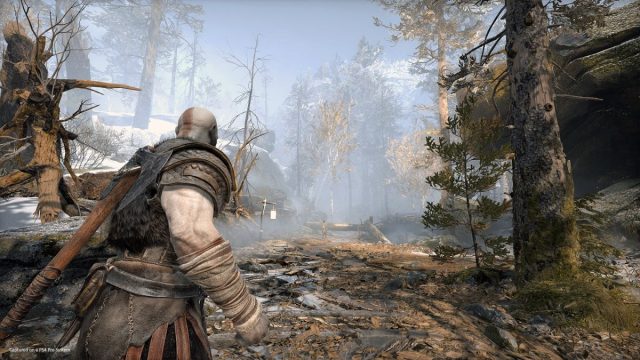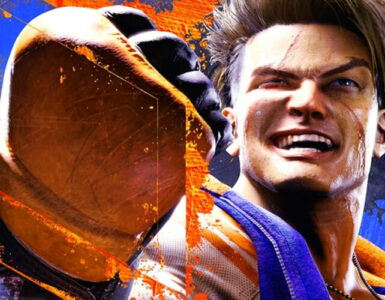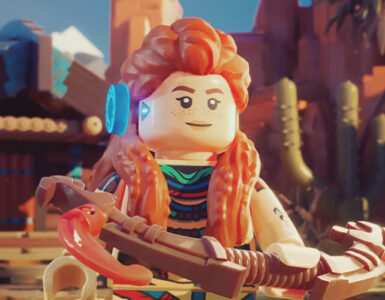For more impressions of the game, click here as we talk more about the first few hours of the new God of War! And check out what God of War felt like to a fresh pair of eyes that are new to the series!
Five years ago, Aaron Kaufman was just starting work at Santa Monica Studios when he was tapped to help develop what would become the new sequel to the hit PlayStation exclusive, God of War.
Currently the Senior Community Strategist at Santa Monica Studio, Kaufman popped by Singapore earlier this month to preview the highly anticipated game to a few key media, and we managed to steal some of his time, to discuss about all things God of War (minor spoilers ahead):
Geek Culture: The game looks simply stunning. With almost five years of development coming to an end, how excited is the studio to get this game (God of War) into the hands of the gamers?
Aaron Kaufman: I started at Santa Monica just before the development of this game, and at that time, I was working on God of War: Ascension in a similar role. And when Cory (Barlog, creative director) came back to the studio, he spent some time in a kind of hibernation with a very small team of about twelve people.
Probably about six months in, they did a presentation where he basically shared his vision for where he wanted to take the game and the hairs on my skin rose when I heard that. I will never forget it, he was just so passionate, he had this very clear idea of a father and son on an incredible journey, changing the character, changing the game, but still making it feel like God of War.
And now, coming five years later, the journey to get here feels as long as the journey that they’re going on, and I couldn’t be more excited! I think, truly, that it’s a riveting journey, I think people are going to be bawling their eyes out, laughing, smiling. There’s a lot of it, it’s an emotional ride, I’m pumped!
GC: How long would mainlining through the game take, on average?
AK: Mainlining through the game would take about 25-35 hours, so we’ve said that, and we stand by that. There’s a lot to see, it is easily the longest and largest God of War game to date.
GC: This particular game is about Kratos’ and Atreus’ deeply personal journey to the highest peak in the land to spread the ashes of his wife, Faye, and with this being what the future holds for the entire series, what important touchstones does Santa Monica want to share with the players?
AK: I think the three key touchstones are combat, narrative, and exploration.Those all weave their way into how important we have fundamentally changed the game, and those three pillars are what’s going to carry God of War into the future.
The new camera, the relationship between father and son, continuing to open up and explore, and dive deeper into this Norse universe. The journey they are on right now, is a catalyst for what’s going to bring them together, they are going to learn so much about each other that by the end of the game, I think they would really feel like a truly bonded father and son, and we’re very proud of where God of War can go from here.
GC: So it’s safe to say this is not the last we will see of Atreus?
AK: I don’t know if anything about the God of War universe is safe, but I would say that the way we’re looking at this is the beginning of something new, and what that something new is in the future, is deep in the mind of Cory.
GC: Having spent some time with Atreus, what makes him such a special character to the studio and to the God of War universe?
AK: Yeah, so that’s a great question. Bringing Atreus into this game was really, probably the biggest signifier that we are taking Kratos somewhere new, that we are giving him more dimensionality. If we just kept him as this angry God with the blades and all that stuff, it wouldn’t feel evolved, and Kratos needs a reason to still be on this planet.
He needs a reason to go on a journey, he needs new purpose, and that’s who Atreus is, Atreus is the reason that Kratos is continuing to wake up every day and moves on to the next one and get to the highest peak.
Atreus’ other primary role is being his ally, his support weapon. It is incredibly deliberate that this is not just an escort mission. He’s functioning as a weapon, as a character in and of himself. He’s capable, upgradable, he is strategic, so it was critical to us at Santa Monica that we continue to create a strong, single-player game, but that we gave Kratos a new purpose in combat and story.
GC: With the fixed camera gone, replaced with a new over-the-shoulder camera, it’s a brand new way to experience God of War, so how important is it, not just for combat, but how you guys are trying to push this new narrative focus for God of War?
AK: Yeah, I mean, I love that question. Two answers there. So, number one, changing the camera just brings a fundamentally different emotional feeling to this game. In old God of War games, you’re looking at it from almost a sky point of view, and you don’t really feel brought into the world, you don’t feel as connected to the action.
The camera, now being unhinged over your shoulder, when a draugr is racing at you and you are getting ready to throw that axe at his head, you feel that. You feel the momentum, the intensity, that only an over shoulder camera can do.
The other big thing, Cory, at the beginning, had this idea. What if the camera never cuts away? What if, the entire game, we see the adventure just like Kratos will, we are seeing it through his eyes. Like some very famous scenes in movies that have these very long one-shots, these very long takes, but if our whole game was like that.
So he set this challenge to the team, and everybody was like, “You’re crazy! We can’t do this, it’s not going to play like that, how are we going to do that,” and he challenged them, and you know, with a far, far complex camera systems, cinematography, the way we mo-cap the actors, we got it, we nailed it.
And so the game, from the first frame to the end, the camera never cuts away. It’s an incredible feat and it just makes you feel a part of the story from start to finish.
GC: Having experienced the new camera and environmental puzzles, how important is environmental storytelling in God of War?
AK: Hugely important, the team spent a ton of time creating this world based on Norse history, Norse mythology, and even some inspiration from 80s fantasy films like The Neverending Story. Those three pillars, together, kind of created this term that the art environmental team called mythical realism. And I think when you play this game, it feels like a world you could actually go to.
The environment is very, very important to the gameplay, the storytelling, to see things that are larger than life, to see secrets around every corner, to seeing structures that might have runic inscriptions that are written on them that you wanna go up and read and touch. So I think, with respect to puzzles, they play a huge role in the game. They get progressively harder, but they all have reasons, they all have a practicality to them.
GC: So they all have a story to tell?
AK: They do, whether it’s a mini story or playing into a larger story, I think that one of the first puzzles you’ve encountered where you’re moving the runic globe, I don’t know if you have gotten there yet, but there’s a puzzle where you have to, essentially, match up these runic letters and Kratos seems to use the axe to kind of, move the wheel and stop it.
But then, Atreus, being the one who knows how to translate the runes, he needs to read it for them to progress so Kratos can’t get beyond this puzzle in this secret cave without Atreus there. So again, it is really important to have Atreus there to help progress through each of these obstacles and puzzles.
GC: Having a companion changes the normal formula of gameplay of God of War.
AK: Oh, hundred million percent! Having a companion, Atreus, again, gameplay, exploration, story, without Atreus, none of the pillars are realized as strong as they are.
GC: So we found some Jötnar Shrines, and saw some Hidden Chambers as well, so I am guessing there are more collectables to be found.
AK: Yeah, absolutely. And everything has a purpose. So we didn’t really want to just put collectables and shrines and toys and Idunn Apples. There are so many different secrets and things to discover in the game, it really adds a whole new layer to a God of War game that’s never been seen before.
But again, it’s not just throw away, the shrines tell the story of these giants that existed in Norse mythology that Atreus is teaching Kratos more about, this world they are in. And when you collect them all, you are gonna unlock a massive XP reward, maybe some other secrets.
So there’s reason to want to collect everything, you don’t have to, you’re not necessarily missing out on the game, but for that player that wants to go beyond that, max out, wants to learn about all the lore that we’ve put behind this, collecting is a very important thing.
GC: We mentioned combat, and it’s way different now. It feels more visceral, more in your face, is there any room for the more magical aspects of old God of War games to come back?
AK: Yeah, I mean, there’s definitely magic in the game, so as you progress, you will unlock more Runic abilities. Kratos has these two gem slots on the axe, so you can mix and match to unlock elemental abilities like an ice slam. All those things bring magic into the game, Atreus’ arrows are imbued with electricity later down the road, so magic is a big part of the game.
GC: Speaking of weapons… so, Blades of Chaos, gone forever?
AK: I think Kratos acknowledges his past, he still has the scars on his forearm. Where the Blades are is something we are not focused on. We’re really focused on the axe and why he has that, and the strength that the axe brings to him. And we think players are going to feel every bit at home with that as any past weapons that Kratos has had.
GC: I’m guessing that there are more weapons down the road for players to get?
AK: There’re more things to discover down the road. (laughs)
GC: Is there any reason why the studio decided to go more RPG-like?
AK: The biggest reason is just choice, it’s really not a complex answer. Past God of War games have been kind of a one-way street in combat and the kind of way you can choose to play. We gave you a choice by having the Cestus or the Blades, a single track weapon that you could switch out anytime and have different abilities about it.
Now, with more RPG-like elements, you have armour, your axe, you have different ways to upgrade each of those. You have your shield, the melee, you have Atreus. All of these things can be upgraded whether in their abilities or giving them new elemental effects.
I think, for the team, it just came down to, let’s give the players more strategic choice, how they want to play the game.
GC: The game is immersed in Norse mythology, and we have met Zeus, Poseidon, Hades and the Greek Pantheon that Kratos basically destroyed. And I have just seen The Stranger, is that how we are going to see the Norse gods, in a different interpretation?
AK: This is our twist on Norse mythology, and it is no secret Kratos and Atreus are going to encounter Norse Gods and monsters. They are walking the same soil they are standing on, who they encounter, when and how, those are our deepest, darkest secrets and those are things, you know, I think when you see a trailer for a movie, a lot of times it’ll kind of spoil it for you right, and this game is something that we don’t want to spoil.
We want players to just be awe-inspired, to be surprised. So what they think we shown them, we really haven’t, we have only shown a sliver of what this game is truly about and we are really excited for people to discover.
GC: We have all seen the God of War inspired PS4 Pro, with Kratos’ axe, the Leviathan, being the inspiration, could you take us through design process?
AK: I personally had a hand in helping design the Pro with Cory and our team. We had a lot of different ideas, actually, at one point, we were going to see if we could have like, the runes on the side actually light up at night, that would have been pretty cool, a little out of budget.
The design of the Pro, I think everybody expected us to do like the mark of Kratos, like a red slash, and kind of in the spirit of the game, we wanted to do something unexpected. The axe has so much lore and gameplay meaning to it, and you could say that the Pro is so strong and powerful that those two things kinda married together.
What was really important to us was we wanted the console and the controller to feel like the axe as a whole. The top panel is the skill tree that you see on the blade of Kratos’ axe, the controller’s symbol is purposely minimalist, it has the brand of the brothers who created the axe, and that’s actually on the handle of the axe in the game as well. So it’s kind of like the controller and the blade working in concert.
The runes on the side, while they are not on the axe, that is more of a narrative accent. Each one of those runes is from our official logo, the serpent. They represent a different realm in the game that you will travel to. This Pro really tells a strong story when you dig into it.
GC: Having seen God of War go from strength to strength, from 2005 to now, in anticipation of Kratos’ next grand quest, what would you like to say to all the excited fans waiting for this April 20?
AK: We just want to continue to tell God of War fans that he may look like a different Kratos, he may have a different weapon, he may have a son, the camera might be unhinged, but the moment you pick up and play, in the first ten minutes or the first time you encounter the draugrs, it’s gonna feel like a God of War game.
It feels as much like a God of War game as any past and it feels like a natural next step. So I think we are eager to see fans’ responses and we are very confident that fans are gonna love it!
For more impressions of the game, click here as we talk more about the first few hours of the new God of War!


















